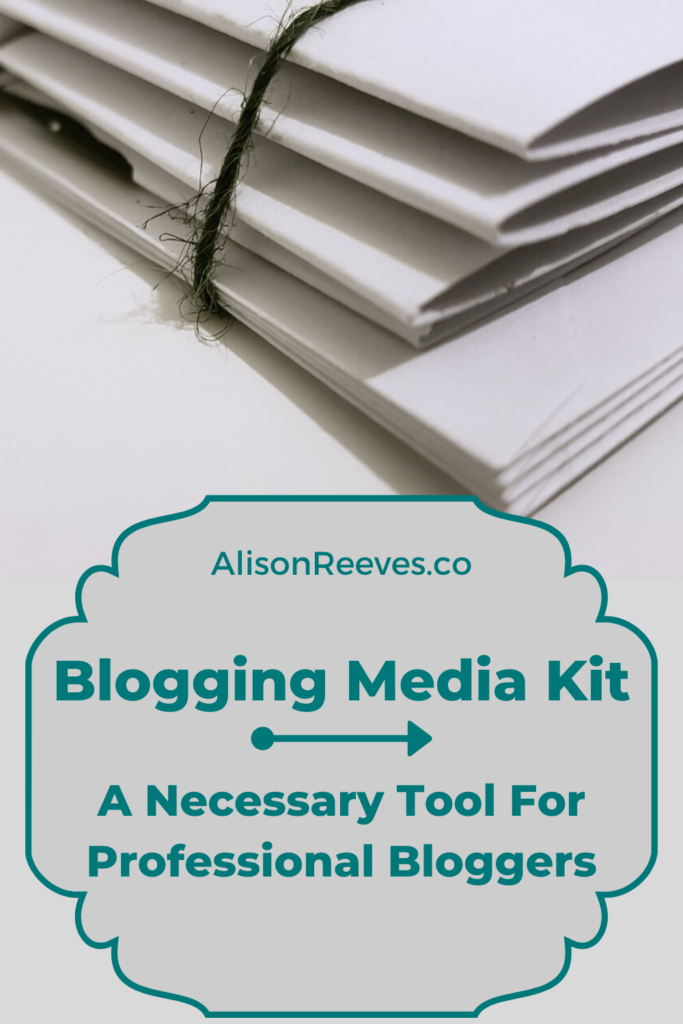The longer I blogged the bigger my goals got and the more apparent it became that I really needed to create a blogging media kit.
I have been blogging for a long time trying to figure out how to monetize my little website side gig. Part of monetizing started with some traffic and successful ad revenue, and I generated a little revenue from mini courses I put out to my growing list on occasion.
But my traffic was so successful that my list grew and became one of my biggest assets. So income options like selling my list and more lucrative collaborations became increasingly more of an option for me.
When trying to work with others, I needed a way to present myself and my brand to potential partners and built my first blogging media kit.
Table of Contents
ToggleWhat Is A Blogging Media Kit?
A blogging media kit is kind of like a mini portfolio for your blogging business. It outlines current statistics and shows sponsors, vendors, partners or collaborators what opportunities you provide to work together.
A blogger’s media kit outlines key aspects of your blog. It shows your credentials, display your branding, list your typical blog topics and provide any other relevant information to potential affiliates, advertisers or partners.
You might provide social media statistics or previous promotional examples.
Why You Should Have A Blogging Media Kit
If you are planning on trying to monetize your blog, you definitely want to build a media kit for yourself. As your audience and influence grows, a blogging media kit ensures that your blog is ready for opportunities. I was offered sponsor opportunities very early on in my blogging journey, so I like to advise blogging clients to have a media kit ready – just in case!
A blogger’s media kit establishes credibility with potential collaborators. And like I said – start now!
Having a media kit prepared in advance also establishes professionalism for your blog. It provides a solid foundation for your brand and relationships with potential partners.
Your media kit should also include a list of collaborative options and prices, but I recommend keeping it simple and uncomplicated. Don’t overwhelm potential partners with confusing options. If they have questions or custom proposals, they are usually forthcoming.
Blogging Media Kit Suggestions
These are great suggestions for building any kind of professional portfolio.
Here is a list of suggested items you should be adding to your blogging media kit.
1. About Me
You want to describe yourself in detail, but as it relates to your brand. Tell your story and your transformation as it relates to your avatar’s pain points and solutions.
You want to express personality here and be transparent, but keep it relevant. It’s not a bad place to list credentials if you do it tastefully. No one wants to see you list of extracurriculars from high school…
2. Contact Info
Maybe this seems silly to mention, but you need to let the potential partner know how to get a hold of you. Provide your contact info, email address and phone number.
You can also provide other social media links like how they can find you, your blog link, your LinkedIn profile, a way to opt into your list, or whatever else is relevant to keeping track of you.
(unless it’s relevant because you are a blogger about high school extracurricular activities.)
3. Blog Bio
You will want to include some info on your blog. Let them know the history of why you started your blog in your blogging media kit.
Tell them why and how it started, what your mission was and how it has evolved over time. Include your tagline and your blog’s messaging. You might even consider sharing information about your audience demographics.
4. Excitement
Make your blogging media kit exciting. Your portfolio is like a personal sales page. Make it visual. Include lots of graphics. But also keep everything on brand. Do you need to highlight more data or something more graphic?
Don’t shy away from personal photos and add plenty of design to make it interesting, just like you would any sales page you were trying to get someone hooked on.
5. Information And Stats
It can’t be all excitement. Sometimes you just need some hard statistics for convincing. Provide a list of social media followers, engagement stats, email list details, monthly pageviews and any other relevant facts about your blog and your business to your media kit.
6. Options
Go ahead and list your collaborative options for potential partners. You do not have to include all options. Decide what you are interested in working with. Sponsored Posts? Giveaways? Product Reviews?
List your options and your pricing. You do not have to offer everything or be everything to everyone. Decide what is best for your brand and streamline your relationships.
7. Examples
What good is a portfolio without some real life examples of what you’ve done? Your blogging media kit should include examples of previous projects, references and testimonials.
If you have worked with certain brands, visually showing brand partnerships with a list of logos is a really pleasing way to list references. You should always be requesting testimonials from former clients as a business owner.
Now What Do I Do With My Blogging Media Kit?
Now that you have your blogging media kit, you can do one of two things.
You can keep it under your belt and have it available. You can continue doing what you are doing and have the media kit available if someone asks for it.
Or if you are looking to monetize quicker and be more proactive, you can research relevant partnerships and reach out to them directly with your media kit in hand.
If you are a beginner blogger looking for other good foundational tips, here are some goals you should be aiming for when you get started.

Free: Mindful Marketing Newsletter
Join 6,500 others on our newsletter.

